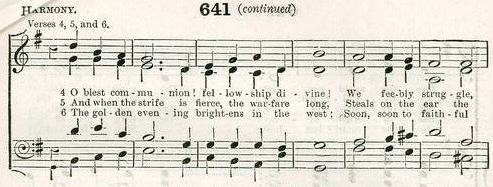In the Christian liturgical calendar, today is All Saints’ Day, which prompts me to consider small textual point about a hymntune that will be much in use today in Anglican services. Ralph Vaughan Williams wrote his tune SINE NOMINE for the text “For all the saints who from their labors rest” as a processional hymn in The English Hymnal (1906), for which he served as music editor. This book revolutionized the music of Anglo-American hymnody, incorporating a wealth of traditions (chorales, Genevan Psalms, plainchant, folk music) into a new mainstream. In addition to many hymn arrangements of folk tunes, Vaughan Williams contributed a several original tunes to the book. SINE NOMINE is probably RVW's best known hymntune, but there are a handful of other contenders for that distinction.
Some fifty years after the fact, RVW described his work on the hymnal partly as one of purging the Victorian hymntune repertory:
Whilst trying to include all the good tunes, I did my best to eliminate the bad ones. This was difficult, because I was not entirely my own master. My committee insisted that certain very popular tunes should be retained. The climax came when my masters declared that I must myself write a fulsome letter to a prominent ecclesiastic asking for leave to print his horrible little tune. My committee and I finally settled our quarrel with a compromise by which the worst offenders were confined to an appendix at the end of the book, which we nicknamed the “Chamber of Horrors.” (p. 3)
In his preface to the volume itself he is somewhat more restrained: “...a short appendix is added of alternative tunes to certain hymns for the use of those who do not agree with the choice of the musical editor.” (p. xii). Joseph Barnby's tune for "For all the saints" was clearly one not to RVW's taste, as it is confined to the Appendix. Charles Villiers Stanford's stirring tune ENGELBURG (1904) was under copyright in the new edition of Hymns Ancient & Modern, and thus not available for The English Hymnal. So Vaughan Williams wrote his own.
Below on the left is the beginning of the hymn as it appeared in the first edition. The hymnal appeared in a second edition in 1933, and the image on the right is how it appears there. Ignore the difference in formatting: the textual variant is bb. 4-6.
 |
| Source: cropped digital scans (600 dpi) of (L) The English Hymnal (OUP) 1906 ed., p. 826; and (R) The English Hymnal (OUP) 1933 ed., p. 832. |
The harmony of b. 4 is identical (tonic) in both versions, but in the later edition the walking bassline of the pedal is changed in order to accommodate a new harmony (V/V) in b. 5. This, in turn, allows a suspended E on the downbeat of b. 6, resolving back to the 1906 text in the middle of that measure.
I have wondered about this passage for years. This hymn is always in the service when I am on the organ bench on All Saints
’ Day
—or on the Sunday nearest to it. It appears in many American hymnals, some with the 1906 text (as I first came to know it), and some with the revised text. Why and when was the change made?
It is hard to date when it was changed, but earliest example I have found with the revised reading is another hymnal which RVW edited, namely
Songs of Praise (OUP) which appeared first in 1925:
 |
| Source: cropped digital scan Songs of Praise (OUP) 1925, p. 162. |
If anyone can locate this reading in any printing of the first edition of
The English Hymnal, I would be eager to know about it. (A number of separate pamphlets of hymns from
The English Hymnal were published over the years, including
one in 1921 that included
“For all the Saints.
” The only copy I have located is in the British Library, and for this post I haven't been able to check the reading there. Perhaps the alteration was made at that time?) Hymns are often the victims of cavalier and arbitrary musical alterations, as often the music editors of a hymnal are not really editors at all; at least in this instance, where Vaughan Williams was the musical editor and this is his own hymn tune, we can rule out the arbitrary and cavalier as a factors.
As to why the change was made, I can only suggest a possible reason. Over the first notes of the hymn are instructions:
 |
| Source: detail of The English Hymnal (OUP) 1906 ed., p. 826. |
Verses 4-6 are given a four-part harmony setting:
 |
| Source: detail of The English Hymnal (OUP) 1906 ed., p. 828. |
There we note that the
“original
” harmony is used for bb. 5-6, and that all that is lacking of the original in b. 4 is the walking bass of the organ pedal line. My suggestion is that, as this harmonization would appear in three verses already, RVW made an alteration for the other five just for the sake of variety. I can
’t prove it, and I
’ve never been convinced that is an improvement. But while I
’m on the subject of this alternate four-part setting, I think the counterpoint for the Alleluyas is gorgeous, the tenor line in particular:
 |
| Source: ditto |
Here is
a performance from York Minster; it uses the 1906 reading through verse 7. At
verse 8, the revised reading is used. I
’ll remember that idea the next time it is on the service list when I am on the bench.







